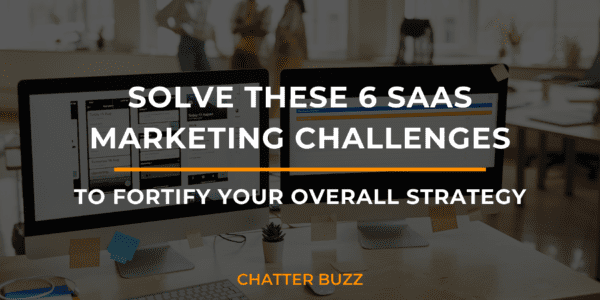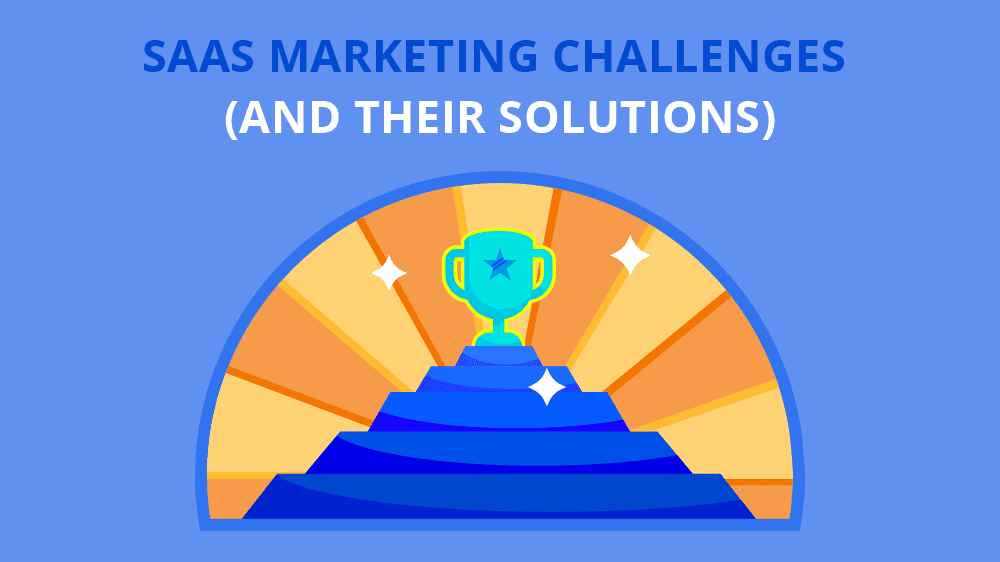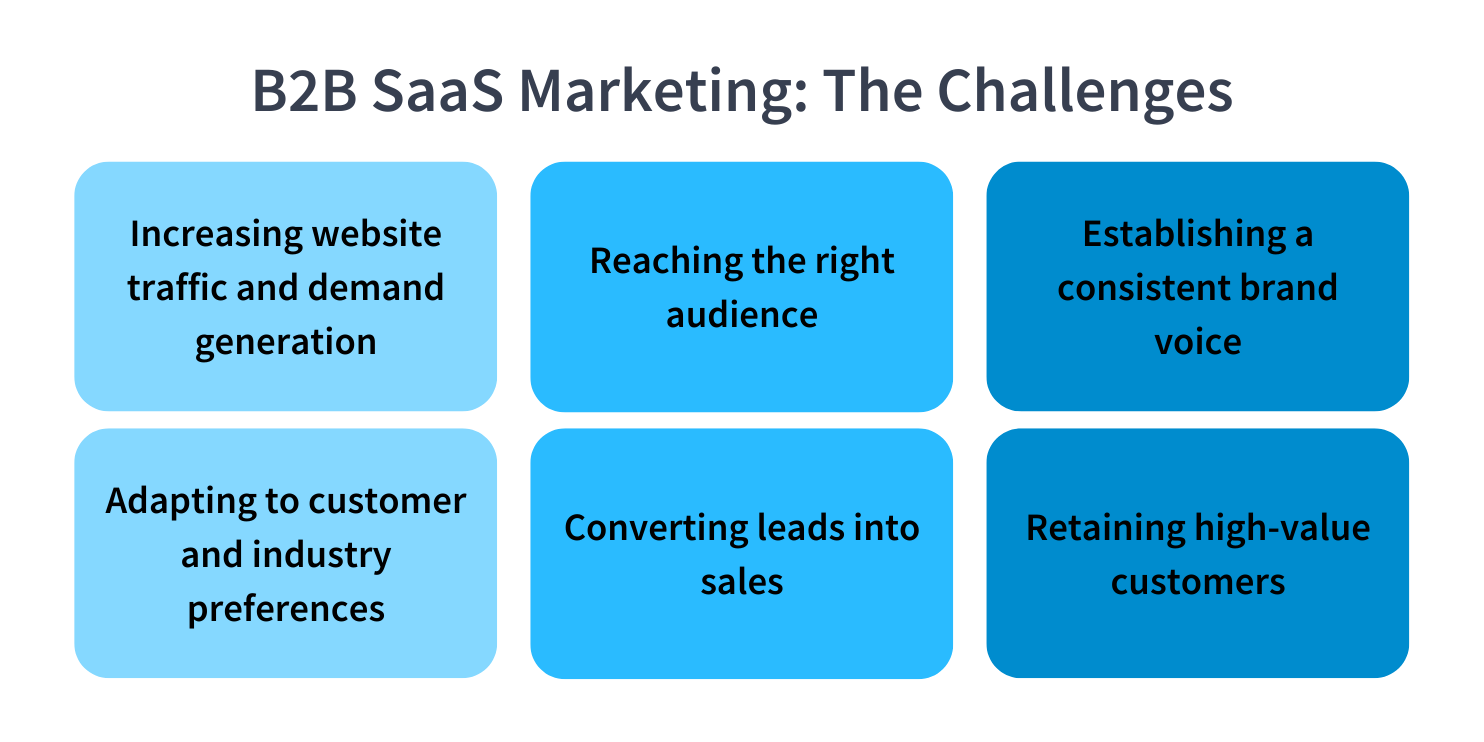SaaS marketing faces challenges like high competition and customer retention. Standing out and keeping customers engaged is crucial.
SaaS businesses operate in a highly competitive market. Effective differentiation is necessary to attract and retain customers. Marketing strategies must be innovative and dynamic. Engaging content, clear messaging, and targeted campaigns are essential. Focusing on customer experience can enhance loyalty.
Analytics and customer feedback should guide improvements. A strong online presence with SEO-optimized content helps visibility. Social proof, like testimonials, can build trust. Continuous adaptation to market trends is vital. Understanding customer needs and pain points drives effective solutions. SaaS marketers must balance acquisition costs with long-term value. Efficiently addressing these challenges leads to sustainable growth and success.

Credit: www.chatterbuzzmedia.com
Introduction To Saas Marketing
Software as a Service (SaaS) is a booming industry. SaaS companies offer software that users access online. Marketing these services presents unique challenges. Let’s dive into the basics of SaaS marketing.
What Is Saas?
SaaS stands for Software as a Service. It’s a model where software is hosted online. Users access it through the internet. This eliminates the need for physical installations. SaaS can be used on any device with internet access.
Examples of SaaS include Google Workspace, Slack, and Salesforce. These services offer flexibility and scalability. Users can access them from anywhere.
Importance Of Marketing In Saas
Marketing is crucial for SaaS success. It helps attract and retain customers. Effective marketing builds brand awareness. It also educates potential users about the product’s benefits.
Here are some key reasons why marketing is vital in SaaS:
- Customer Acquisition: Marketing helps bring in new users.
- Customer Retention: Good marketing keeps existing users engaged.
- Brand Awareness: Marketing spreads knowledge about the SaaS product.
- Competitive Edge: It differentiates the product from competitors.
- Revenue Growth: More customers lead to increased revenue.
| Reason | Explanation |
|---|---|
| Customer Acquisition | Marketing attracts new users to the platform. |
| Customer Retention | Engaging content keeps current users loyal. |
| Brand Awareness | Marketing increases product visibility. |
| Competitive Edge | Effective strategies set the product apart. |
| Revenue Growth | More users lead to higher earnings. |
Each of these points highlights the role of marketing in SaaS. Without it, SaaS products struggle to grow.
Target Audience Identification
Identifying your target audience is crucial for successful SaaS marketing. It helps you tailor your efforts and maximize your impact. Without a clear understanding of your audience, you risk wasting resources. Let’s explore key strategies for pinpointing your ideal customer.
Defining Your Ideal Customer
Your ideal customer is the person who benefits most from your product. Start by creating a detailed buyer persona. Include:
- Demographics – Age, gender, education, income
- Geographics – Location, climate, urban/rural
- Psychographics – Interests, values, lifestyle
- Behavioral – Buying habits, product usage, brand loyalty
Interview existing customers to gather insights. Use surveys and social media analytics. This data helps refine your persona and tailor marketing messages.
Market Segmentation Strategies
Market segmentation divides your audience into smaller, manageable groups. Each segment has unique characteristics. Common segmentation strategies include:
| Segmentation Type | Description |
|---|---|
| Geographic | Based on location, climate, and region. |
| Demographic | Based on age, gender, income, and education. |
| Psychographic | Based on lifestyle, values, and personality. |
| Behavioral | Based on user behavior and product interaction. |
Use a combination of these strategies for better precision. For example, target young professionals in urban areas who value innovation. Tailored campaigns are more effective and yield higher conversions.
Leverage tools like Google Analytics and CRM software. These tools provide valuable data for segmentation. The more specific your segments, the better you can address their needs.
Lead Generation Techniques
Generating leads is vital for any SaaS company. The right techniques attract potential customers and boost conversions. Below are some effective lead generation techniques.
Content Marketing
Content marketing is a powerful tool for SaaS lead generation. Creating valuable, relevant content can attract and engage your target audience.
- Blog Posts: Write informative blog posts about industry trends and solutions.
- Ebooks and Guides: Offer in-depth resources in exchange for contact information.
- Webinars: Host live sessions to discuss key topics and interact with potential leads.
Optimizing your content for search engines helps reach a broader audience. Use SEO strategies like keyword research and on-page optimization.
Paid Advertising
Paid advertising can quickly generate leads for your SaaS business. It involves paying for ad placements on various platforms.
- Google Ads: Target specific keywords related to your services.
- Social Media Ads: Promote your content on platforms like Facebook and LinkedIn.
- Retargeting Ads: Show ads to users who visited your site but didn’t convert.
Paid ads can be expensive, so monitor your campaigns closely. Analyze metrics and adjust strategies to maximize ROI.
Below is a quick comparison table for the two techniques:
| Technique | Pros | Cons |
|---|---|---|
| Content Marketing | Cost-effective, builds trust, improves SEO | Time-consuming, requires consistent effort |
| Paid Advertising | Immediate results, broader reach | Expensive, requires constant budget |

Credit: crunch-marketing.com
Building Brand Awareness
Building brand awareness is crucial for the success of any SaaS company. It ensures that potential customers recognize and trust your brand. This leads to increased conversions and customer loyalty. Let’s explore some key strategies for building brand awareness.
Social Media Engagement
Social media platforms are powerful tools for increasing brand visibility. Engaging with your audience on these platforms can significantly enhance your brand’s presence. Here are some tips:
- Post regularly on platforms like Facebook, Twitter, and LinkedIn.
- Share valuable content that solves your audience’s problems.
- Respond to comments and messages promptly to build trust.
- Use hashtags to reach a broader audience.
- Collaborate with influencers in your industry.
Seo Best Practices
Search Engine Optimization (SEO) is essential for making your SaaS brand discoverable. Implementing effective SEO strategies can drive organic traffic to your website. Here are some best practices:
- Keyword Research: Identify and use relevant keywords in your content.
- On-Page SEO: Optimize meta tags, headings, and content structure.
- Quality Content: Create valuable, informative, and engaging content.
- Backlink Building: Obtain backlinks from reputable websites.
- Mobile Optimization: Ensure your website is mobile-friendly.
Using these strategies can significantly improve your brand’s visibility on search engines. It helps potential customers find your SaaS products more easily.
Retention And Churn Reduction
Retaining customers is crucial for SaaS businesses. High churn rates can hinder growth. Customer retention ensures steady revenue. Reducing churn is vital for long-term success. Below are key strategies to enhance retention.
Customer Onboarding
Customer onboarding is the first step to retention. A smooth onboarding process sets the tone. It helps users understand the product quickly. A great onboarding process includes:
- Interactive tutorials to guide new users
- Personalized onboarding emails for engagement
- 24/7 customer support for immediate help
A comprehensive onboarding experience reduces confusion. It helps users achieve quick wins. This boosts their confidence in the product.
Regular Engagement
Regular engagement keeps customers interested. Frequent communication builds a strong relationship. Use these methods to maintain engagement:
| Method | Description |
|---|---|
| Email Campaigns | Send updates and tips to users |
| Webinars | Educate users about advanced features |
| Surveys | Gather feedback to improve the product |
Regular engagement shows customers you care. It helps them find value in your product. This reduces the chances of them leaving.
Pricing Strategy Challenges
SaaS companies often face significant pricing strategy challenges. Choosing the right pricing model is crucial. It impacts customer acquisition, retention, and overall profitability. Let’s explore some common issues under Competitive Pricing and Value-Based Pricing.
Competitive Pricing
Competitive pricing is vital in the SaaS market. Many players offer similar solutions. Here are some key points:
- Understanding competitor pricing structures
- Offering comparable or better value
- Balancing price and quality
It’s essential to monitor competitor pricing. Use tools and market research. This helps to stay competitive without sacrificing margins.
Value-based Pricing
Value-based pricing focuses on the perceived value to the customer. This approach requires:
- Identifying customer needs and preferences
- Communicating the unique value proposition
- Adjusting prices based on the value delivered
Here’s a table to highlight differences:
| Competitive Pricing | Value-Based Pricing |
|---|---|
| Focus on market rates | Focus on customer value |
| Price wars are common | Emphasizes unique benefits |
| Risk of lower margins | Potential for higher profits |
In value-based pricing, customer feedback is crucial. Regular surveys and analytics can help. Adjust your pricing to reflect the value customers perceive. This ensures they feel they are getting their money’s worth.
Navigating Market Competition
In the fast-paced world of SaaS, navigating market competition is crucial. SaaS companies face many competitors, making it vital to stand out. Effective strategies can turn market challenges into growth opportunities.
Differentiation Tactics
Standing out in a crowded market requires unique approaches. Employing differentiation tactics helps your SaaS product shine.
- Unique Features: Introduce features that competitors lack.
- Customer Experience: Provide stellar support and user experience.
- Brand Story: Create a compelling and relatable brand narrative.
Analyzing Competitors
Understanding competitors is key to a successful strategy. Analyzing their strengths and weaknesses can provide invaluable insights.
| Competitor | Strengths | Weaknesses |
|---|---|---|
| Competitor A | Wide user base, advanced features | Poor customer service, high prices |
| Competitor B | Affordable, easy to use | Limited features, small user base |
Use this data to refine your marketing strategy. Focus on areas where you can outperform competitors.

Credit: www.webapper.com
Measuring Success
Measuring success in SaaS marketing is crucial. It helps understand what works and what doesn’t. This process involves tracking specific metrics and listening to customer feedback. Both aspects provide valuable insights to improve strategies and achieve better results.
Key Performance Indicators
Key Performance Indicators (KPIs) are vital for measuring success. They provide specific, measurable goals. Here are some essential KPIs for SaaS marketing:
- Customer Acquisition Cost (CAC): Total cost to acquire a new customer.
- Monthly Recurring Revenue (MRR): Predictable revenue stream each month.
- Customer Lifetime Value (CLV): Total revenue a customer will generate during their lifetime.
- Churn Rate: Percentage of customers who cancel their subscription.
- Conversion Rate: Percentage of visitors who become paying customers.
Monitoring these KPIs helps optimize marketing strategies. This leads to better resource allocation and higher returns.
Customer Feedback
Customer feedback is another critical aspect of measuring success. It provides direct insights from users. Gathering feedback can be done through various methods:
- Surveys: Simple and quick way to gather data.
- Interviews: More in-depth understanding of customer experiences.
- Net Promoter Score (NPS): Measures customer loyalty and satisfaction.
- Reviews and Testimonials: Provide social proof and insights.
Customer feedback helps identify areas of improvement. It also highlights what customers love about your product. Acting on feedback can significantly enhance user satisfaction and retention.
Future Trends In Saas Marketing
The world of SaaS marketing is evolving fast. New trends are shaping how companies reach their audience. Two key trends are AI and Automation, and Personalization. These trends will define the future of SaaS marketing.
Ai And Automation
AI and Automation are changing the marketing landscape. They help streamline tasks and improve efficiency. AI can analyze large data sets quickly. This provides valuable insights for decision-making.
Automation tools handle repetitive tasks. This includes email campaigns, social media posts, and ad management. Using AI, businesses can predict customer behavior. This makes targeting more precise and effective.
Here are some benefits of AI and Automation in SaaS marketing:
- Increased productivity
- Better data analysis
- Enhanced customer targeting
- Cost savings
Personalization
Personalization is key in today’s marketing strategies. Customers expect tailored experiences. Personalization uses data to create unique interactions. This can be through emails, content, or product recommendations.
Personalized marketing boosts engagement and conversion rates. It makes customers feel valued and understood. Businesses can use customer data to segment their audience. This allows for more targeted and relevant messaging.
Examples of personalization in SaaS marketing include:
- Custom email campaigns
- Personalized product recommendations
- Tailored content
- Targeted ads
These future trends in SaaS marketing are transforming the industry. Embracing AI and Automation, and Personalization will help businesses stay competitive and meet customer expectations.
Frequently Asked Questions
What Are Common Saas Marketing Challenges?
Common SaaS marketing challenges include high competition, customer retention, and demonstrating value. These issues can hinder growth. Effective strategies can mitigate these challenges and drive success.
How To Improve Saas Customer Retention?
Improving SaaS customer retention involves excellent customer support, regular updates, and user engagement. Personalized communication and value-driven content also help. These strategies build loyalty.
Why Is Saas Competition Intense?
SaaS competition is intense due to the low entry barriers and high demand. Many companies offer similar solutions. Differentiation through unique features and superior customer service is crucial.
How To Demonstrate Saas Value Effectively?
To demonstrate SaaS value, use case studies, customer testimonials, and clear ROI metrics. Highlight unique features and benefits. This approach convinces potential customers of your product’s worth.
Conclusion
Navigating SaaS marketing challenges requires a strategic approach. Embrace adaptability and leverage data-driven insights to stay competitive. Focus on understanding your target audience and refining your strategies accordingly. With perseverance and innovation, your SaaS business can overcome obstacles and thrive in a dynamic market environment.
Keep evolving to achieve sustainable growth.
